ISM频段上蓝牙与802.11b的共存机制
- 格式:doc
- 大小:322.50 KB
- 文档页数:8
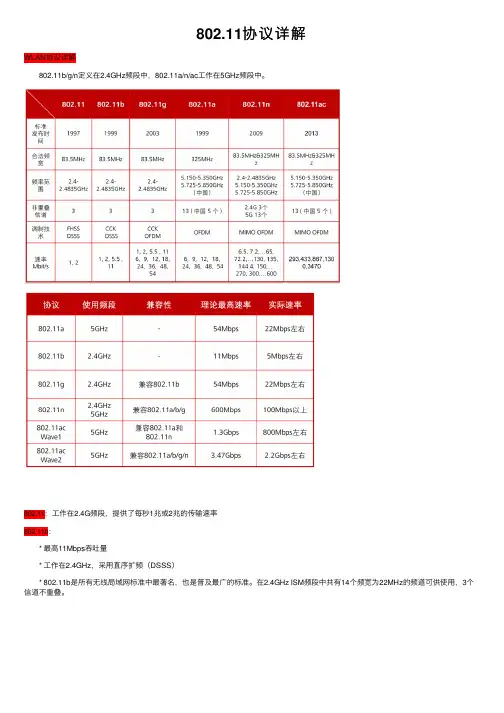
802.11协议详解WLAN协议详解 802.11b/g/n定义在2.4GHz频段中,802.11a/n/ac⼯作在5GHz频段中。
802.11:⼯作在2.4G频段,提供了每秒1兆或2兆的传输速率802.11b: * 最⾼11Mbps吞吐量 * ⼯作在2.4GHz,采⽤直序扩频(DSSS) * 802.11b是所有⽆线局域⽹标准中最著名,也是普及最⼴的标准。
在2.4GHz ISM频段中共有14个频宽为22MHz的频道可供使⽤,3个信道不重叠。
802.11g: * 最⾼速率54Mbps * 802.11g⼯作在2.4GHz频段 * 802.11g采⽤正交频分复⽤(OFDM),⽀持6、9、12、18、24、36、48、54Mbps数据速率及802.11b速率⽀持13个信道802.11a: * 最⾼速率达54Mbps * 802.11a⼯作在5GHz * 802.11a采⽤正交频分复⽤(OFDM),⽀持6、9、12、18、24、36、48、54Mbps数据速率802.11n: * 最⾼速率可达600Mbps * 802.11n协议为双频⼯作模式,⽀持2.4GHz和5GHz,兼容802.11a/b/g标准兼容 * 802.11n采⽤MIMO与OFDM相结合 * 传输距离⼤⼤增加 * 提⾼⽹络吞吐量性能 802.11n优势: * 速率提升-更多的⼦载波 802.11a/g在20MHz模式下有48个可⽤⼦载波,速度可达54Mbps 802.11n在20MHz模式下有52个可⽤⼦载波,速度可达58.5Mbps * 速率提升-编码率 * 速率提升-Short GI 在⽆线收发过程中收/发间或多次传发过程中,需要若⼲间隔时间,⽽这个间隔时间就成为Guard Interval,简称GI Short Guard Interval 更短的帧间保护间隔 802.11a/b/g标准要求在发送数据时,必须保证在数据之间存在800ns的时间间隔,802.11n仍缺省使⽤800ns,当多径效应不严重时,可以将该间隔配置为400ns,可以将吞吐量提升近10% Short GI使⽤⽤于多径情况较少、射频环境较好的应⽤场景。
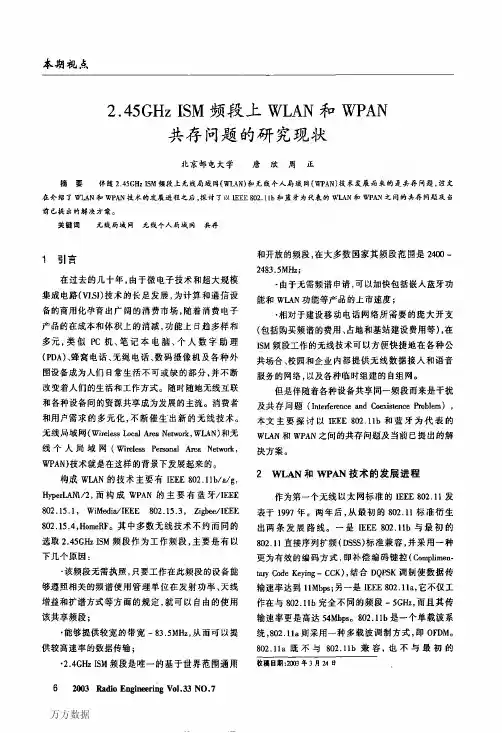
本期视点2.45GHzISM频段上WLAN和WPAN共存问题的研究现状北京邮电大学唐欣周正摘要伴随245GHzISM颤段上无线局斑同(wLAN)和无线个人局域网(WrAN)技术发展而来的是共存问题.该史在介绍了WLAN和WPAN技术的发展进程之后,探讨了以IEEE802.1lb扣蓝牙为代表的WIAN和WPA.N'之间的共存问题厦当酋已提出的解决方案。
关键词无线局域网无线个人局域网共存1引言在过去的几十年,由于微电子技术和超大规模集成电路(VtSl)技术的长足发展,为计算和通信设备的商用化孕育出广阔的消费市场,随着消费电子产品的在成本和体积上的消减,功能上日趋多样和多元,类似Pc机、笔记本电脑、个人数字助理(PDA)、蜂窝电话、无绳电话、数码摄像机及各种外围设备成为人们日常生活不可或缺的部分,并不断改变着人们的生活和工作方式。
随时随地无线互联和各种设备间的资源共享成为发展的主流。
消费者和用户需求的多元化,不断催生出新的无线技术。
无线局域网(WitlessLocalAreaNetwoIk,WLaN)和无线个人局域网(WimlessPersonalAreaNetwork,WPAN)技术就是在这样的背景下发展起来的。
构成WLAN的技术主要有IEEE802.11b/a/g,HyperLANl/2,而构成WPAN的主要有蓝牙/1EEE802.15.1,WiMedia/IEEE802.15.3,Zigbee/lEEE802.15.4,HomeRF。
其中多数无线技术不约而同的选取2.45GHzISM频段作为工作频段,主要是有以下几个原因:・该频段无需执照,只要工作在此频段的设备能够遵照相关的频谱使用管理单位在发射功率、天线增益和扩谱方式等方面的规定,就可以自由的使用该共享频段:・能够提供较宽的带宽一83.5MHz.从而可以提供较高速率的数据传输;・2.4GHzISM频段是唯一的基于世界范围通用62003RadioEngir№ringV01.33NO.7和开放的频段,在大多数国家其频段范围是2400—2483.5MHz;・由于无需频谱申请,可以加快包括嵌入蓝牙功能和WLAN功能等产品的上市速度;・相对于建设移动电话网络所需要的庞大开支(包括购买频谱的费用、占地和基站建设费用等),在ISM频段工作的无线技术可以方便快捷地在各种公共场合、校园和企业内部提供无线数据接人和语音服务的网络,以及各种临时组建的自组网。
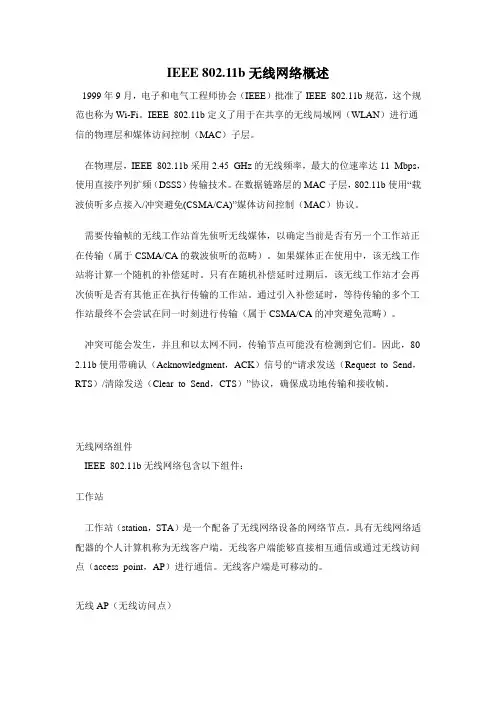
IEEE 802.11b无线网络概述1999年9月,电子和电气工程师协会(IEEE)批准了IEEE 802.11b规范,这个规范也称为Wi-Fi。
IEEE 802.11b定义了用于在共享的无线局域网(WLAN)进行通信的物理层和媒体访问控制(MAC)子层。
在物理层,IEEE 802.11b采用2.45 GHz的无线频率,最大的位速率达11 Mbps,使用直接序列扩频(DSSS)传输技术。
在数据链路层的MAC子层,802.11b使用“载波侦听多点接入/冲突避免(CSMA/CA)”媒体访问控制(MAC)协议。
需要传输帧的无线工作站首先侦听无线媒体,以确定当前是否有另一个工作站正在传输(属于CSMA/CA的载波侦听的范畴)。
如果媒体正在使用中,该无线工作站将计算一个随机的补偿延时。
只有在随机补偿延时过期后,该无线工作站才会再次侦听是否有其他正在执行传输的工作站。
通过引入补偿延时,等待传输的多个工作站最终不会尝试在同一时刻进行传输(属于CSMA/CA的冲突避免范畴)。
冲突可能会发生,并且和以太网不同,传输节点可能没有检测到它们。
因此,80 2.11b使用带确认(Acknowledgment,ACK)信号的“请求发送(Request to Send,RTS)/清除发送(Clear to Send,CTS)”协议,确保成功地传输和接收帧。
________________________________________________________________无线网络组件IEEE 802.11b无线网络包含以下组件:工作站工作站(station,STA)是一个配备了无线网络设备的网络节点。
具有无线网络适配器的个人计算机称为无线客户端。
无线客户端能够直接相互通信或通过无线访问点(access point,AP)进行通信。
无线客户端是可移动的。
无线AP(无线访问点)无线AP是在STA和有线网络之间充当桥梁的无线网络节点。
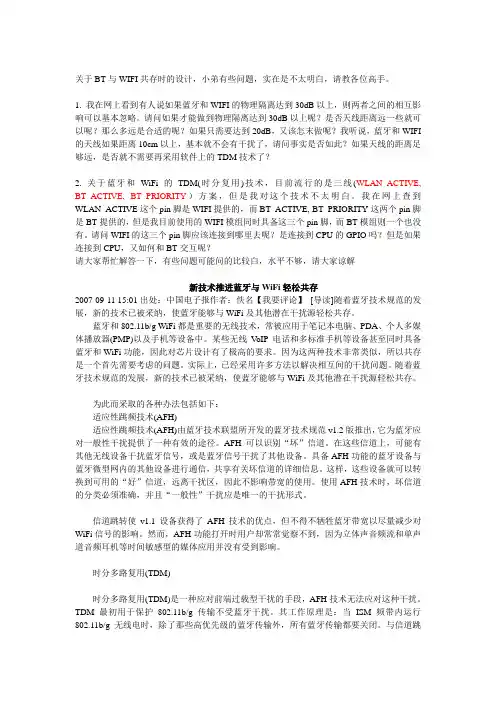
关于BT与WIFI共存时的设计,小弟有些问题,实在是不太明白,请教各位高手。
1. 我在网上看到有人说如果蓝牙和WIFI的物理隔离达到30dB以上,则两者之间的相互影响可以基本忽略。
请问如果才能做到物理隔离达到30dB以上呢?是否天线距离远一些就可以呢?那么多远是合适的呢?如果只需要达到20dB,又该怎末做呢?我听说,蓝牙和WIFI 的天线如果距离10cm以上,基本就不会有干扰了,请问事实是否如此?如果天线的距离足够远,是否就不需要再采用软件上的TDM技术了?2. 关于蓝牙和WiFi的TDM(时分复用)技术,目前流行的是三线(WLAN_ACTIVE, BT_ACTIVE, BT_PRIORITY)方案,但是我对这个技术不太明白。
我在网上查到WLAN_ACTIVE这个pin脚是WIFI提供的,而BT_ACTIVE, BT_PRIORITY这两个pin脚是BT提供的,但是我目前使用的WIFI模组同时具备这三个pin脚,而BT模组则一个也没有。
请问WIFI的这三个pin脚应该连接到哪里去呢?是连接到CPU的GPIO吗?但是如果连接到CPU,又如何和BT交互呢?请大家帮忙解答一下,有些问题可能问的比较白,水平不够,请大家谅解新技术推进蓝牙与WiFi轻松共存2007-09-11 15:01出处:中国电子报作者:佚名【我要评论】[导读]随着蓝牙技术规范的发展,新的技术已被采纳,使蓝牙能够与WiFi及其他潜在干扰源轻松共存。
蓝牙和802.11b/g WiFi都是重要的无线技术,常被应用于笔记本电脑、PDA、个人多媒体播放器(PMP)以及手机等设备中。
某些无线V oIP电话和多标准手机等设备甚至同时具备蓝牙和WiFi功能,因此对芯片设计有了极高的要求。
因为这两种技术非常类似,所以共存是一个首先需要考虑的问题。
实际上,已经采用许多方法以解决相互间的干扰问题。
随着蓝牙技术规范的发展,新的技术已被采纳,使蓝牙能够与WiFi及其他潜在干扰源轻松共存。
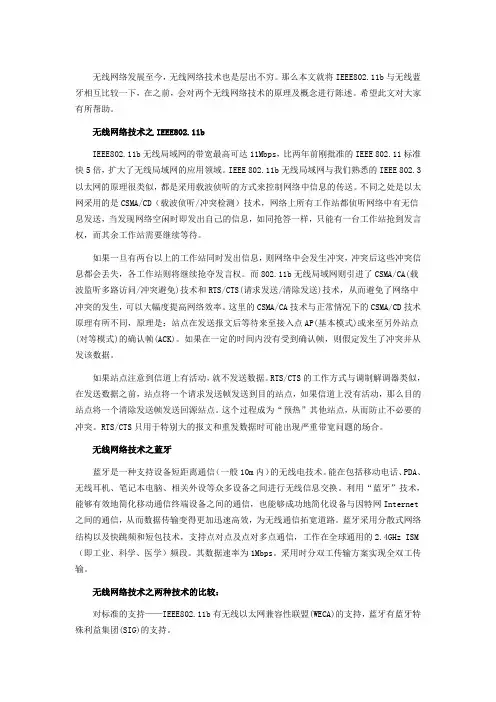
无线网络发展至今,无线网络技术也是层出不穷。
那么本文就将IEEE802.11b与无线蓝牙相互比较一下,在之前,会对两个无线网络技术的原理及概念进行陈述。
希望此文对大家有所帮助。
无线网络技术之IEEE802.11bIEEE802.11b无线局域网的带宽最高可达11Mbps,比两年前刚批准的IEEE 802.11标准快5倍,扩大了无线局域网的应用领域。
IEEE 802.11b无线局域网与我们熟悉的IEEE 802.3以太网的原理很类似,都是采用载波侦听的方式来控制网络中信息的传送。
不同之处是以太网采用的是CSMA/CD(载波侦听/冲突检测)技术,网络上所有工作站都侦听网络中有无信息发送,当发现网络空闲时即发出自己的信息,如同抢答一样,只能有一台工作站抢到发言权,而其余工作站需要继续等待。
如果一旦有两台以上的工作站同时发出信息,则网络中会发生冲突,冲突后这些冲突信息都会丢失,各工作站则将继续抢夺发言权。
而802.11b无线局域网则引进了CSMA/CA(载波监听多路访问/冲突避免)技术和RTS/CTS(请求发送/清除发送)技术,从而避免了网络中冲突的发生,可以大幅度提高网络效率。
这里的CSMA/CA技术与正常情况下的CSMA/CD技术原理有所不同,原理是:站点在发送报文后等待来至接入点AP(基本模式)或来至另外站点(对等模式)的确认帧(ACK)。
如果在一定的时间内没有受到确认帧,则假定发生了冲突并从发该数据。
如果站点注意到信道上有活动,就不发送数据。
RTS/CTS的工作方式与调制解调器类似,在发送数据之前,站点将一个请求发送帧发送到目的站点,如果信道上没有活动,那么目的站点将一个清除发送帧发送回源站点。
这个过程成为“预热”其他站点,从而防止不必要的冲突。
RTS/CTS只用于特别大的报文和重发数据时可能出现严重带宽问题的场合。
无线网络技术之蓝牙蓝牙是一种支持设备短距离通信(一般10m内)的无线电技术。
能在包括移动电话、PDA、无线耳机、笔记本电脑、相关外设等众多设备之间进行无线信息交换。

IEEE 802.11•维基百科,自由的百科全书•本页面最后修订于2010年5月6日(星期四) 07:47IEEE 802.11是如今无线局域网通用的标准,它是由IEEE所定义的无线网络通信的标准。
虽然有人将Wi-Fi与802.11混为一谈,但两者并不一样。
(见IEEE 802.11b)历史自第二次世界大战,无线通讯因在军事上应用的成果而受到重视,无线通讯一直发展,但缺乏广泛的通讯标准。
于是,IEEE在1997年为无线局域网制定了第一个版本标准──IEEE 802.11。
其中定义了媒体存取控制层(MAC层)和物理层。
物理层定义了工作在2.4GHz的ISM 频段上的两种展频作调频方式和一种红外传输的方式[1],总数据传输速率设计为2Mbit/s。
两个设备之间的通信可以设备到设备(ad hoc)的方式进行,也可以在基站(Base Station, BS)或者访问点(Access Point,AP)的协调下进行。
为了在不同的通讯环境下取得良好的通讯质量,采用 CSMA/CA (Carrier Sense Multi Access/Collision Avoidance)硬件沟通方式。
1999年加上了两个补充版本:802.11a定义了一个在5GHz ISM频段上的数据传输速率可达54Mbit/s的物理层,802.11b定义了一个在2.4GHz的ISM频段上但数据传输速率高达11Mbit/s的物理层。
2.4GHz 的ISM频段为世界上绝大多数国家通用,因此802.11b得到了最为广泛的应用。
苹果公司把自己开发的802.11标准起名叫AirPort。
1999年工业界成立了Wi-Fi联盟,致力解决符合802.11标准的产品的生产和设备兼容性问题。
802.11标准和补充。
•IEEE 802.11,1997年,原始标准(2Mbit/s,工作在2.4GHz)。
•IEEE 802.11a,1999年,物理层补充(54Mbit/s,工作在5GHz)。
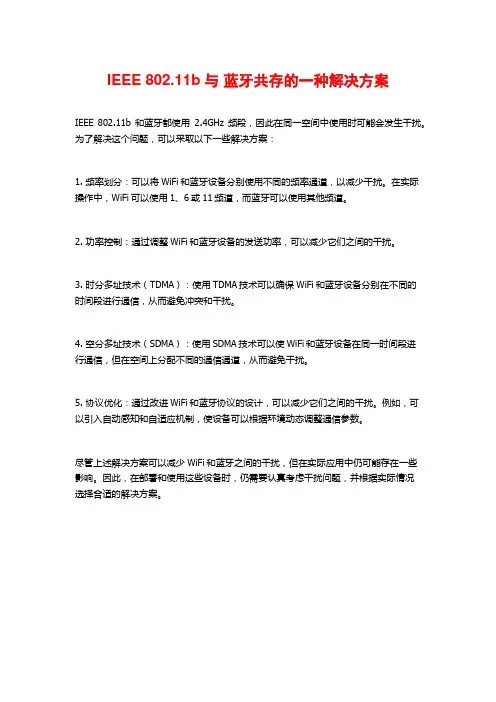
IEEE 802.11b与蓝牙共存的一种解决方案
IEEE 802.11b和蓝牙都使用2.4GHz频段,因此在同一空间中使用时可能会发生干扰。
为了解决这个问题,可以采取以下一些解决方案:
1. 频率划分:可以将WiFi和蓝牙设备分别使用不同的频率通道,以减少干扰。
在实际操作中,WiFi可以使用1、6或11频道,而蓝牙可以使用其他频道。
2. 功率控制:通过调整WiFi和蓝牙设备的发送功率,可以减少它们之间的干扰。
3. 时分多址技术(TDMA):使用TDMA技术可以确保WiFi和蓝牙设备分别在不同的
时间段进行通信,从而避免冲突和干扰。
4. 空分多址技术(SDMA):使用SDMA技术可以使WiFi和蓝牙设备在同一时间段进
行通信,但在空间上分配不同的通信通道,从而避免干扰。
5. 协议优化:通过改进WiFi和蓝牙协议的设计,可以减少它们之间的干扰。
例如,可以引入自动感知和自适应机制,使设备可以根据环境动态调整通信参数。
尽管上述解决方案可以减少WiFi和蓝牙之间的干扰,但在实际应用中仍可能存在一些影响。
因此,在部署和使用这些设备时,仍需要认真考虑干扰问题,并根据实际情况
选择合适的解决方案。
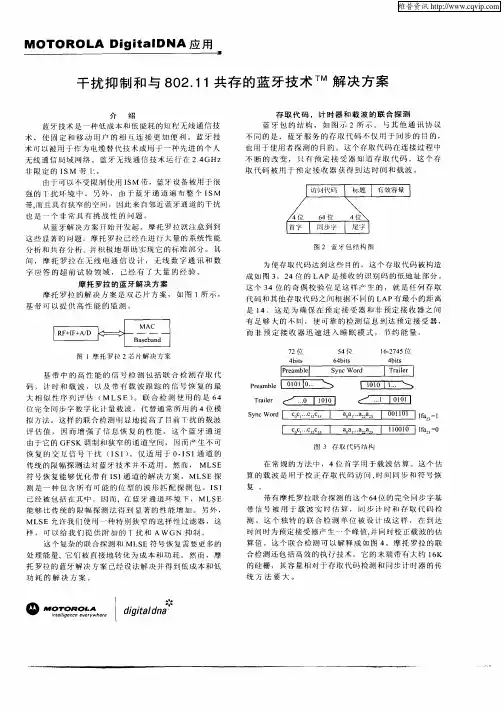
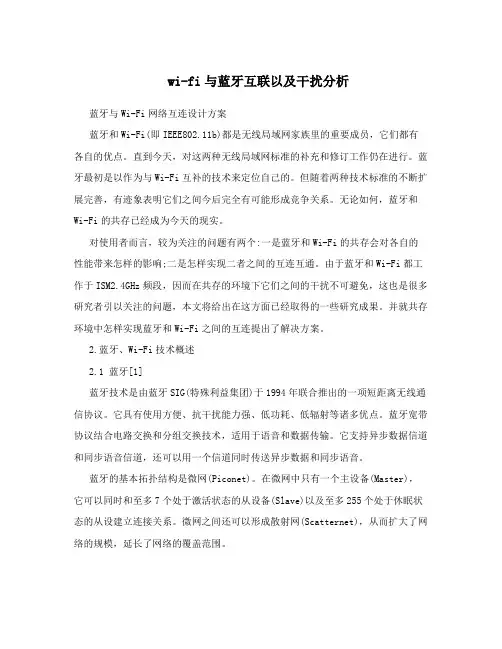
wi-fi与蓝牙互联以及干扰分析蓝牙与Wi-Fi网络互连设计方案蓝牙和Wi-Fi(即IEEE802.11b)都是无线局域网家族里的重要成员,它们都有各自的优点。
直到今天,对这两种无线局域网标准的补充和修订工作仍在进行。
蓝牙最初是以作为与Wi-Fi互补的技术来定位自己的。
但随着两种技术标准的不断扩展完善,有迹象表明它们之间今后完全有可能形成竞争关系。
无论如何,蓝牙和Wi-Fi的共存已经成为今天的现实。
对使用者而言,较为关注的问题有两个:一是蓝牙和Wi-Fi的共存会对各自的性能带来怎样的影响;二是怎样实现二者之间的互连互通。
由于蓝牙和Wi-Fi都工作于ISM2.4GHz频段,因而在共存的环境下它们之间的干扰不可避免,这也是很多研究者引以关注的问题,本文将给出在这方面已经取得的一些研究成果。
并就共存环境中怎样实现蓝牙和Wi-Fi之间的互连提出了解决方案。
2.蓝牙、Wi-Fi技术概述2.1 蓝牙[1]蓝牙技术是由蓝牙SIG(特殊利益集团)于1994年联合推出的一项短距离无线通信协议。
它具有使用方便、抗干扰能力强、低功耗、低辐射等诸多优点。
蓝牙宽带协议结合电路交换和分组交换技术,适用于语音和数据传输。
它支持异步数据信道和同步语音信道,还可以用一个信道同时传送异步数据和同步语音。
蓝牙的基本拓扑结构是微网(Piconet)。
在微网中只有一个主设备(Master),它可以同时和至多7个处于激活状态的从设备(Slave)以及至多255个处于休眠状态的从设建立连接关系。
微网之间还可以形成散射网(Scatternet),从而扩大了网络的规模,延长了网络的覆盖范围。
2003年3月,IEEE批准了兼容蓝牙1.1版本的WPAN标准“IEEE802.15.1”,同时还专门成立了四个工作组专门负责IEEE802.15相关标准的制定和完善动作。
目前,更为完善的蓝牙协议2.0版已经问世,这必将加速蓝牙技术的推广应用进程。
2.2 Wi-Fi[2]Wi-Fi是在IEEE802.11的基础修改制定的,于1999年11月由IEEE推出。
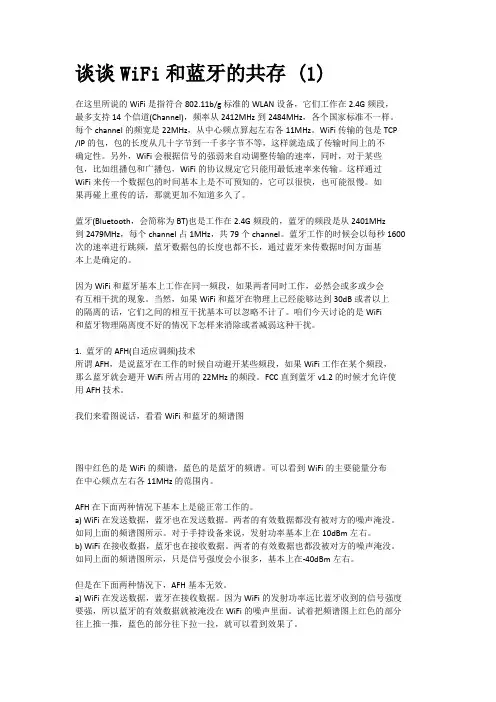
谈谈WiFi和蓝牙的共存 (1)在这里所说的WiFi是指符合802.11b/g标准的WLAN设备,它们工作在2.4G频段,最多支持14个信道(Channel),频率从2412MHz到2484MHz,各个国家标准不一样。
每个channel的频宽是22MHz,从中心频点算起左右各11MHz。
WiFi传输的包是TCP /IP的包,包的长度从几十字节到一千多字节不等,这样就造成了传输时间上的不确定性。
另外,WiFi会根据信号的强弱来自动调整传输的速率,同时,对于某些包,比如组播包和广播包,WiFi的协议规定它只能用最低速率来传输。
这样通过WiFi来传一个数据包的时间基本上是不可预知的,它可以很快,也可能很慢。
如果再碰上重传的话,那就更加不知道多久了。
蓝牙(Bluetooth,会简称为BT)也是工作在2.4G频段的,蓝牙的频段是从2401MHz到2479MHz,每个channel占1MHz,共79个channel。
蓝牙工作的时候会以每秒1600 次的速率进行跳频,蓝牙数据包的长度也都不长,通过蓝牙来传数据时间方面基本上是确定的。
因为WiFi和蓝牙基本上工作在同一频段,如果两者同时工作,必然会或多或少会有互相干扰的现象。
当然,如果WiFi和蓝牙在物理上已经能够达到30dB或者以上的隔离的话,它们之间的相互干扰基本可以忽略不计了。
咱们今天讨论的是WiFi和蓝牙物理隔离度不好的情况下怎样来消除或者减弱这种干扰。
1. 蓝牙的AFH(自适应调频)技术所谓AFH,是说蓝牙在工作的时候自动避开某些频段,如果WiFi工作在某个频段,那么蓝牙就会避开WiFi所占用的22MHz的频段。
FCC直到蓝牙v1.2的时候才允许使用AFH技术。
我们来看图说话,看看WiFi和蓝牙的频谱图图中红色的是WiFi的频谱,蓝色的是蓝牙的频谱。
可以看到WiFi的主要能量分布在中心频点左右各11MHz的范围内。
AFH在下面两种情况下基本上是能正常工作的。
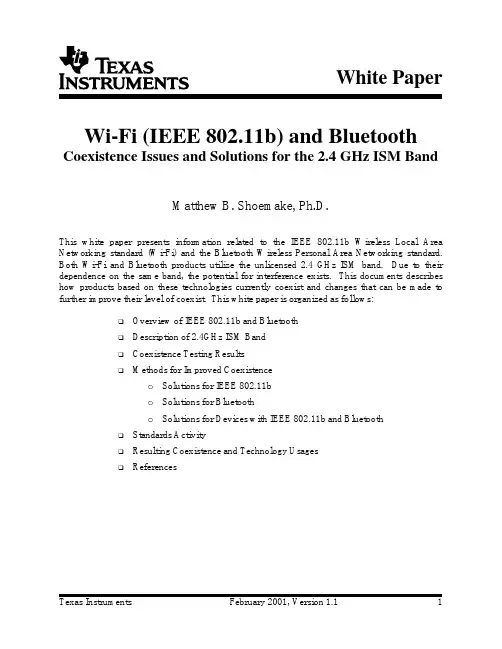
White Paper Wi-Fi (IEEE 802.11b) and Bluetooth Coexistence Issues and Solutions for the 2.4 GHz ISM BandMatthew B. Shoemake, Ph.D.This white paper presents information related to the IEEE 802.11b Wireless Local Area Networking standard (Wi-Fi) and the Bluetooth Wireless Personal Area Networking standard. Both Wi-Fi and Bluetooth products utilize the unlicensed 2.4 GHz ISM band. Due to their dependence on the same band, the potential for interference exists. This documents describes how products based on these technologies currently coexist and changes that can be made to further improve their level of coexist. This white paper is organized as follows:G Overview of IEEE 802.11b and BluetoothG Description of 2.4GHz ISM BandG Coexistence Testing ResultsG Methods for Improved Coexistenceo Solutions for IEEE 802.11bo Solutions for Bluetootho Solutions for Devices with IEEE 802.11b and BluetoothG Standards ActivityG Resulting Coexistence and Technology UsagesG ReferencesTable of Contents1 Overview of Wi-Fi and the IEEE 802.11b Standard (3)2 Overview of Bluetooth 1.0 (3)3 The 2.4GHz ISM Band (4)4 Wi-Fi and Bluetooth Coexistence Testing (7)4.1 TestingSetup (7)Performance (8)4.2 BaselineThroughput (8)4.2.1 Wi-Fi4.2.2 BluetoothThroughput (9)4.3 Wi-Fi Performance with Bluetooth Interferer (9)4.4 Bluetooth Performance with IEEE 802.11b WLAN Interferer (11)5 Methods for Improved Coexistence (12)5.1 Dynamic Channel Selection for Wi-Fi Networks (13)5.2 Adaptive Fragmentation for Wi-Fi Networks (13)5.3 Bluetooth Coexistence Enhancements (14)FrequencyHopping (14)5.4 Intelligent5.5 Transmit Power Control (15)5.6 Methods for Collocated Wi-Fi and Bluetooth (15)Activity (16)6 Standards7 Results and Usages (16)8 References (16)List of FiguresFigure 1-1 Typical Wi-Fi (IEEE 802.11b) Baseband Signal Power (3)Figure 2-1 Typical Bluetooth Signal Power Spectrum (4)Figure 3-1 Bluetooth Frequency Occupancy Example (5)Figure 3-2 Frequency Occupancy of Three Wi-Fi networks (6)Figure 4-1 Wi-Fi AP and Station Icons (7)Figure 4-2 Bluetooth Master and Slave Icons (7)Figure 4-3 Wi-Fi Baseline Test Set-up (8)Figure 4-4 Wi-Fi Baseline Throughput (8)Figure 4-5 Bluetooth Baseline Test Set-up (9)Figure 4-6 Bluetooth Baseline Throughput (9)Figure 4-7 Wi-Fi Throughput with Bluetooth Nearby Interferer Test Setup (10)Figure 4-8 Wi-Fi Throughput with Bluetooth Interferer at Distance Test Set-up (10)Figure 4-9 Wi-Fi Throughput with Bluetooth Interferer (11)Figure 4-10 Bluetooth Throughput with Wi-Fi Interferer (12)1 Overview of Wi-Fi and the IEEE 802.11b StandardThe IEEE 802.11b standard [11] is a specification for Wireless Local Area Networks (WLAN). The Wireless Ethernet Compatibility Alliance (WECA) acts as a certification organization for products that interoperate with one another via the IEEE 802.11b standard. Products that achieve certification are deemed Wi-Fi compliant.Wi-Fi systems transmit data in the unlicensed 2.4GHz ISM band. Data is transmitted on BPSK and QPSK constellations at 11Msps. A square-root raised cosine pulse-shaping filter may be used in Wi-Fi systems to conform to the spectral mask requirements of the IEEE 802.11b standard. A relatively large excess bandwidth (or bandwidth expansion factor) is used for the pulse-shaping filter, which results in a typical spectral mask as shown in Figure 1-1.Figure 1-1 Typical Wi-Fi (IEEE 802.11b) Baseband Signal PowerWi-Fi products transmit at data rates up to 11Mbps. Typically, Wi-Fi devices operate at distances up to 100 meters, however, range varies as a function of transmit power and environment, e.g. indoors versus outdoors.2 Overview of Bluetooth 1.0The Bluetooth standard is a specification for Wireless Personal Area Networks (WPAN). Although products based on the Bluetooth standard are often capable of operating at greater distances, the targeted operational area is the area around an individual, e.g. within 10 meters of the user. The spectral mask of a Bluetooth signal is 1 MHz wide at the 20dB points, as is shown in Figure 2-1.Figure 2-1 Typical Bluetooth Signal Power SpectrumThe Bluetooth standard is based on frequency hopping spread spectrum technology. Although at any point in time, the Bluetooth signal occupies only 1MHz, the signal changes center frequency (or hops) deterministically at a rate of 1600Hz. Bluetooth hops over 79 center frequencies, so over time the Bluetooth signal actually occupies 79MHz.3 The 2.4GHz ISM BandWi-Fi and Bluetooth products both operate in the unlicensed 2.4GHz ISM band. Although specifications and allowable uses for the band vary based on local regulations, coexistence issues will only be considered with respect to the FCC regulations for the 2.4GHz band in this white paper. Since the FCC regulations tend to be as or more restrictive than those found in other countries, consideration of the coexistence of Bluetooth and Wi-Fi products with respect to them will yield results that are likely to be applicable in other jurisdictions.Although there are many regulations that apply to operation of products within the 2.4GHz ISM band, Section 15.247 of the FCC regulations contains the key requirements for high-power direct sequence and frequency hopping spread spectrum transmissions allowed in the band. The 2.4GHz ISM band is 83.5MHz wide with a lower limit of 2.400GHz and an upper limit of 2.4835GHz.Section 15.247 of the FCC regulations limits operation of high-power transmitters (up to 1 Watt) in the band to direct sequence spread spectrum (DSSS) and frequency hop spread spectrum (FHSS) technologies. Wi-Fi products are based on DSSS technology, and Bluetooth devices are based on FHSS technology.Section 15.247(a) for FHSS devices requires devices to hop over at least 75 channels and limit the maximum bandwidth of each hopping channel to 1MHz. Bluetooth devices hop over 79 frequencies that are 1MHz wide. Thus, over time, Bluetooth devices occupy 79MHz, but at any specific instance only 1MHz is occupied.Figure 3-1 Bluetooth Frequency Occupancy ExampleFigure 3-1 shows how Bluetooth hops in the 2.4GHz ISM band. Each blue rectangle represents a Bluetooth transmission. Bluetooth is a slotted protocol. Each slot is 625µs long. Although atransmission can occupy 1, 3 or 5 slots, only transmissions that are one slot long are shown in Figure 3-1.Each Wi-Fi network maintains the same frequency usage over time and only uses a subset of the 83.5MHz available. The IEEE 802.11b standard defines 11 possible channels that may be used. Each channel is defined by its center frequency. The center frequencies are at intervals of 5MHz from one another. The associated channels are numbered from one to 11.Since the 20dB bandwidth of an IEEE 802.11b signal could easily be as great at 16MHz, using adjacent channels in the same location would result in interference. For this reason collocated Wi-Fi networks are typically operated on channels 1, 6 and 11 to prevent interference. In such a scenario, three collocated networks would occupy approximately 3 x 16MHz = 48MHz of the available 83.5MHz in the ISM band.Figure 3-2 Frequency Occupancy of Three Wi-Fi networksFigure 3-2 shows a typical frequency occupancy for three Wi-Fi networks. Each Wi-Fi network operates exclusively on one channel. The figure shows networks operating on channels 1, 6 and 11. The transmissions of each channel are distinguished by the color of each packet. The duration of each Wi-Fi packet varies based on the amount of data in the packet. There is typically a short acknowledgement packet after each data packet on the network.4 Wi-Fi and Bluetooth Coexistence TestingSince Bluetooth devices hop over 79 MHz of the ISM band and IEEE 802.11b devices require approximately 16MHz of bandwidth to operate, it is not possible to have both Wi-Fi and Bluetooth products in the same area without the chance of interference. Due to the potential for interference, a series of coexistence tests have been run with actual Bluetooth and Wi-Fi products to determine their level of coexistence. The full details of the testing are available in[10]. A summary of the testing is provided in the following sections.4.1 Testing SetupThe throughput testing was performed with a Wi-Fi certified access point (AP) and station. The Wi-Fi station consisted of a laptop computer with a Wi-Fi PCMCIA card. The icons used to represent each of these devices in later sections are shown in Figure 4-1.Figure 4-1 Wi-Fi AP and Station IconsThe Bluetooth devices that were used in the testing were also PCMCIA cards. Two laptops were used to enable one Bluetooth master and one Bluetooth slave. The icons used to represent the Bluetooth devices are shown below in Figure 4-2.Figure 4-2 Bluetooth Master and Slave IconsThis test was intended to obtain empirical data-throughput results, corresponding with certain realistic scenarios in which Bluetooth and Wi-Fi connections may coexist. It is important to realize that many different coexistence scenarios are probable in realistic usage, each Wi-Fi StationWi-Fi APBT MasterBT Slavecharacterized by different relative distances, applications, and performance measures (e.g. voice/image quality or data latency, instead of throughput). The complexity of coexistence performance evaluation is addressed in [11], where various coexistence scenarios are classified and approaches for such evaluation are proposed.4.2 Baseline PerformanceTo obtain the maximum throughput for both the Bluetooth and Wi-Fi networks when there is no interference, baseline tests were performed. In each baseline test, the Chariot software package from NetIQ was used to transfer data as quickly as possible from one device to another.4.2.1 Wi-Fi ThroughputTo obtain a baseline for Wi-Fi, the setup in Figure 4-3 was used. Data was transferred from the access point to the station. Thus during the test, the majority of the packets going from the access point to the station were large payload data packets, while the majority of packets going from the station to the access point were short acknowledgment packets.Figure 4-3 Wi-Fi Baseline Test Set-upThe distance between the Wi-Fi access point and the Wi-Fi station was varied while the two devices had a line of sight between one another. The resulting throughput as a function of distance is shown in Figure 4-4. The result is that the devices maintain a connection speed in excess of 5.5Mbps up to the maximum distance at which the test was performed of 250 feet.Figure 4-4 Wi-Fi Baseline Throughput1234560255075100125150175200225250Distance (ft.)T h r o u g h p u t (M b p s )4.2.2 Bluetooth ThroughputIn analogous fashion to the Wi-Fi baseline throughput testing, two Bluetooth devices were configured as shown in Figure 4-5.Figure 4-5 Bluetooth Baseline Test Set-upData was transferred from the Bluetooth master to the Bluetooth slave with no interference in the area. The resulting throughput was approximately 550 kbps at all distances up to 250 feet. Again all testing was performed with a line of sight between the devices under test. A plot of the throughput achieve on the Bluetooth network is shown in Figure 4-6.Figure 4-6 Bluetooth Baseline Throughput4.3 Wi-Fi Performance with Bluetooth InterfererIn this section the results of two key tests will be shown. The first test is the same as the baseline throughput test in Section 4.2.1 except that a Bluetooth master and slave are both placed within 10cm of the Wi-Fi station. This test is a worst case for Wi-Fi networks. The Bluetooth devices used a transmit power of 100mW, and the Wi-Fi devices used a transmit power of 30mW. Both Bluetooth devices were located within 10cm of the Wi-Fi device that was attempting to receivedata. This set-up is shown in Figure 4-7.0.20.40.60.810255075100Distance (ft.)T h r o u g h p u t (M b p s )Figure 4-7 Wi-Fi Throughput with Bluetooth Nearby Interferer Test SetupThe second test is similar to the first test, except the Bluetooth interferers are moved 30 feet away from the Wi-Fi station. The set-up is shown in Figure 4-8.10mFigure 4-8 Wi-Fi Throughput with Bluetooth Interferer at Distance Test Set-upThe results of these two tests are shown along with the baseline Wi-Fi throughput in Figure 4-9. It is observed that when the Bluetooth interferers are very close to the Wi-Fi station, the impact on performance due to interference is substantial. However, when the Bluetooth interferes are moved as little as 10 meters away, the throughput is only minimally reduced compared to the baseline.12345670255075100125150175200225250Distance (ft.)T h r o u g h p u t (M b p s)Figure 4-9 Wi-Fi Throughput with Bluetooth Interferer 4.4 Bluetooth Performance with IEEE 802.11b WLAN InterfererTo determine the effect of Wi-Fi as an interferer on a Bluetooth network, the same experiments that were carried out in Section 4.3 were carried out again with the Bluetooth and Wi-Fi devices exchanging locations. The results of the tests are shown in Figure 4-10. It can be seen from the results that Bluetooth throughput is impacted when a Wi-Fi device is very close. On the other hand, when the Wi-Fi device is moved away, the Bluetooth throughput significantly improves and is approximately ninety percent of the baseline throughput independent of range.These experiments show that when Bluetooth and Wi-Fi devices are at a reasonable distance from one another, both types of devices obtain the large majority of the throughput that would have been obtained if there were no interference. However, these experiments also demonstrate that interference between the two does degrade performance of both Bluetooth and Wi-Fi devices. In the following sections, the causes of the interference are analyzed and several solutions are discussed.0.10.20.30.40.50.60255075100Distance (ft.)T h r o u g h p u t (M b p s )Figure 4-10 Bluetooth Throughput with Wi-Fi Interferer5 Methods for Improved CoexistenceThe need for coexistence of devices in an unlicensed band is not a new one. A good example of devices that required coexistence with other devices in an unlicensed band is cordless phones in the unlicensed 900 MHz ISM band. When cordless phones for the 900 MHz band were first introduced, they had limited ability to deal with interference in the band. However, over time they added often-simple changes that allowed them to operate in the presence of other 900 MHz devices and still maintain a quality connection.Although there are some differences between the example above and the situation in the 2.4GHz ISM band, the premise remains the same. Due to the potential for other devices operating in the same band, it is necessary to imply features that allow for continued robust performance even in the presence of other devices. Fortunately, the regulations in the 2.4GHz band and most unlicensed bands prevent any device from using more than its fair share of the band. The following sections detail ways to improve coexistence and robustness of Bluetooth and Wi-Fi devices.5.1 Dynamic Channel Selection for Wi-Fi NetworksOne of the best ways to coexist is to avoid using the frequencies in the 2.4GHz ISM band that are occupied by others. The example of coexisting Wi-Fi networks in Figure 3-2 demonstrates this principle. The three collocated networks use channels one, six and eleven to avoid interfering with one another. In current Wi-Fi products, the user or system administrator selects the channel. It is possible to dynamically select the channel on which a Wi-Fi network will operate.Dynamic channel selection allows the Wi-Fi access point itself to determine which channel is best to use depending on the current usage of the band. Determination of which channel is the best to operate on can be achieve by several methods:G Packet Error Rateo Communication with another Wi-Fi device allows packet error rate measurements on each channel. Channels with lower packet error rates are desirable.G Channel Noiseo Communication with another Wi-Fi device allows for measurement of the signal to noise ratio on each channel. Channels with high signal to noise ratios aredesirable.G Channel Multipath and Intersymbol Interferenceo Communication with another Wi-Fi device allows for measurement of the amount of intersymbol interference and multipath that is experienced in the channel.Channels with low amounts of intersymbol interference and multipath aredesirable.G Received Signal Strengtho Independent of having other Wi-Fi devices in the area, an access point can determine which channel to operate on based on the signal strength of interferersin the band. For example, this can be determined by monitoring the setting of theautomatic gain control on each channel.Using the best channel available is not only good for the Wi-Fi network, but it is also good for other users of the 2.4GHz ISM band. It is likely that by choosing the best channel available, the Wi-Fi network would also avoid interfering with other devices using the band.5.2 Adaptive Fragmentation for Wi-Fi NetworksWi-Fi networks have the ability to fragment packets to limit their length. When there is no interference on the network, fragmenting lowers the network throughput, because of the increased overhead of packet headers. However, in the presence of interference, it has been shown [10] that fragmentation can actually increase the throughput.By decreasing the length of each packet, the probability of interference during a Wi-Fi packet can be reduced. There is a tradeoff that must be made between the lower packet error rate that can be achieved by using shorter packets and the increased overhead of more headers on the network. Finding the optimal fragmentation setting to maximize the network throughput on a Wi-Fi network has been addressed in [8].One way to implement adaptive fragmentation is to monitor the packet error rate on the network and accordingly adjust the fragmentation level. The adjustment of the fragmentation level is also a function of the amount of overhead associated with each packet. The optimal fragmentation level can be reached within approximately ten updates using an adaptive least mean squared algorithm.5.3 Bluetooth Coexistence EnhancementsVarious mechanisms can be used to improve the coexistence level of Bluetooth devices when interference is present. An assortment of mechanisms for this purpose is proposed in [5]. For data connections, Bluetooth devices can adaptively select the type of error control used and the length of each packet to transmit in order to maximize the throughput. In addition, flow control can be used to dynamically increase and decrease the rate of transmission. For example, when a contiguous block of bad channels is reached, the Bluetooth device may place traffic on hold until good channels are available.5.4 Intelligent Frequency HoppingFrequency hopping devices have an inherent level of robustness due to the fact that they do not continually transmit at the same frequency. The changing of the transmit center frequency, or hopping, means that the probability of colliding with the transmission of another sufficiently narrowband device at any particular time is very small. This can be seen easily in Figure 3-1. Since the blue rectangles are very sparse in the time versus frequency plot, the probability of colliding with traffic in the band is small.The level of robustness to interference that Bluetooth devices currently have is obtained blindly, since the transmitter uses no knowledge of the interference in the band. If the hop sequences were designed to actively avoid other devices in the band, both the performance of Bluetooth devices and other devices in the band could be improved. For example, if a Wi-Fi device were active on Wi-Fi channel six, it would be advantageous for the Bluetooth device to never transmit in the frequency range 2.429 GHz to 2.445 GHz (see Figure 3-2), since any transmission in this range could result in a Bluetooth and/or Wi-Fi transmission errors.Unfortunately, current FCC regulations require Bluetooth devices to hop over at least 75 channels, so it is impossible to significantly change the frequency range over which Bluetooth devices hop. The FCC has been petitioned by Texas Instruments and other companies to allow Bluetooth and other frequency hopping devices to hop over as little as 15 MHz. Such a change would allow for the design of intelligent hopping schemes that improve Bluetooth performance in a multitude of situations.Even without changes in regulations of the 2.4 GHz ISM band, there are intelligent frequency hopping schemes that would allow for improved throughput in the presence of interferers. Such hopping sequences can be design based on the fact that it is better to have several “good” (clear) hop frequencies in a row rather than alternating randomly between good and “bad” (interfered) hop frequencies. Since acknowledgements are embedded Bluetooth packets, throughput can be improved by hopping through a sequence of good hop frequencies and thereby not needlessly retransmitting any data due to lost acknowledgements. Designing hop sequences that have runsof good hop frequencies and runs of bad hop frequencies, e.g. due to a Wi-Fi device in the area, have been shown to significantly increase the performance of Bluetooth and Wi-Fi devices [1]. Additional coexistence performance enhancement ideas related with the hopping sequence are presented in [10].5.5 Transmit Power ControlWhen using a shared resource such as the 2.4GHz ISM band, it is important to not use more of the resource than is actually required. This can be thought of as a golden rule for using congested bands. For example, if two devices in the band can communicate by transmitting at a power level of 4 dBm, it is an over usage of the band to transmit at 20 dBm. By transmitting too much power in the band, the overall capacity per area is reduced and the communications of other users of the band may be needlessly interfered with.Since the distance between devices does not change rapidly, the required transmit power does not tend to change rapidly either. This means that both Bluetooth and Wi-Fi devices can add dynamic power control without degrading the performance of either device. However, the fact that devices are no longer transmitting at their maximum power levels means that all devices in the area are more likely to be able to communicate with one another successfully.A joint mechanism for rate shifting and power control of Wi-Fi devices is proposed in [7]. In addition, transmit power levels are suggested that can be used for Wi-Fi and Bluetooth devices as well as other users of the 2.4GHz ISM band. A power control approach for Bluetooth is proposed also in [3], where the minimization of transmission power is promoted, even in the presence of interference. Power control is a mechanism that is relatively easy to understand and implement, yet can yield great performance improvements for all users of the band.5.6 Methods for Collocated Wi-Fi and BluetoothWhen Bluetooth and Wi-Fi are located in the same device, the opportunity exists for an even greater level of robustness and coexistence. When Bluetooth and Wi-Fi devices are collocated, a simple signaling scheme with a coordination unit can be used to reserve transmit and receive slots in the channel access timing. A simple scheme for dealing with virtual contention, i.e. when Wi-Fi and Bluetooth devices attempt to make a conflicting reservation, is also desirable.In such a situation it is important to maximize the throughput of both the Bluetooth network and the Wi-Fi networks. It is also important to maintain fairness between Bluetooth and Wi-Fi while avoiding long traffic delays. A scheme to do exactly this has been proposed in [6]. The scheme allows for flexibility in allocating throughput between Wi-Fi and Bluetooth networks. The proposed scheme uses a simple reservation protocol for Bluetooth and Wi-Fi transmissions. The scheme requires only a simple coordination unit to communicate reservations between the Bluetooth and Wi-Fi hardware. In addition, the coordination unit resolves conflicting reservations using a statistical method that also allows for adjustment of the maximum throughput on each network.6 Standards ActivityDue to the importance of coexistence of Bluetooth and IEEE 802.11 devices, both the Bluetooth SIG and the IEEE 802 Working Group are actively looking at methods for improved coexistence. Texas Instruments actively participates in the standardization of methods to improve coexistence in the 2.4 GHz band.The IEEE 802.15.2 Task Group has been formed specifically to consider proposals for mechanisms to improve the level of coexistence between Bluetooth and IEEE 802.11 devices and to come up with recommended practices derived from these. Many of the solutions discussed in Section 5 have been proposed to the Task Group.7 Results and UsagesTexas Instruments is committed to providing Bluetooth and Wi-Fi solutions that are the industry leader in their level of robustness to interference from other devices in the 2.4 GHz ISM band. As a result, both Bluetooth and Wi-Fi devices will be able to coexist in the same area and even within the same device without having a detrimental effect on one another.For example, users will be able to have a laptop that has both Bluetooth and Wi-Fi in it. This will allow the laptop to communicate with a mobile phone or a PDA via Bluetooth, while the Wi-Fi in that laptop is communicating with a high-speed home gateway or with an access point in an enterprise environment. The usage combinations are endless, and with the availability of products having enhanced coexistence capabilities, they will all become realizable.8 References[1] Anuj Batra, Jin-Meng Ho, and Kofi Anim-Appiah, Proposal for Intelligent BT FrequencyHopping for Enhanced Coexistence, IEEE 802.15-01/082, January 2001.[2] Code of Federal Regulations, Title 47, Chapter 1, Part 15, Section 247.[3] Oren Eliezer, Non-Collaborative Mechanisms for the Enhancement of CoexistencePerformance, IEEE 802.15-01/092, January 2001.[4] Oren Eliezer, Evaluation of Coexistence Performance, IEEE 802.15-01/091, January 2001.[5] Jie Liang, Proposal for Non-Collaborative BT Mechanisms for Enhanced Coexistence, IEEE802.15-01/026, January 2001.[6] Jie Liang, Proposal for Collaborative BT and 802.11b MAC Mechanisms for EnhancedCoexistence, IEEE 802.15-01/080, January 2001.[7] Matthew B. Shoemake, Proposal for Power Control for Enhanced Coexistence, IEEE802.15-01/081, January 2001.[8] Matthew B. Shoemake, Proposal for Non-collaborative 802.11 MAC Mechanisms forEnhancing Coexistence: Adaptive Fragmentation, IEEE 802.15-01/083, January 2001.[10] Matthew B. Shoemake and Paul Lowry, IEEE 802.11b and Bluetooth Coexistence TestingResults, IEEE 802.15-01/084, January 2001.[11] Std. IEEE 802.11b-1999, Supplement to Information technology--Telecommunications andinformation exchange between systems--Local and metropolitan area networks--Specific requirements--Part 11: Wireless LAN Medium Access Control (MAC) and Physical Layer (PHY) Specifications: Higher Speed Physical Layer (PHY) Extension in the 2.4 GHz band, September 1999.IMPORTANT NOTICETexas Instruments Incorporated and its subsidiaries (TI) reserve the right to make corrections, modifications, enhancements, improvements, and other changes to its products and services at any time and to discontinue any product or service without notice. Customers should obtain the latest relevant information before placing orders and should verify that such information is current and complete. All products are sold subject to TI’s terms and conditions of sale supplied at the time of order acknowledgment.TI warrants performance of its hardware products to the specifications applicable at the time of sale in accordance with TI’s standard warranty. Testing and other quality control techniques are used to the extent TI deems necessary to support this warranty. Except where mandated by government requirements, testing of all parameters of each product is not necessarily performed.TI assumes no liability for applications assistance or customer product design. Customers are responsible for their products and applications using TI components. To minimize the risks associated with customer products and applications, customers should provide adequate design and operating safeguards.TI does not warrant or represent that any license, either express or implied, is granted under any TI patent right, copyright, mask work right, or other TI intellectual property right relating to any combination, machine, or process in which TI products or services are used. Information published by TI regarding third-party products or services does not constitute a license from TI to use such products or services or a warranty or endorsement thereof. Use of such information may require a license from a third party under the patents or other intellectual property of the third party, or a license from TI under the patents or other intellectual property of TI. Reproduction of information in TI data books or data sheets is permissible only if reproduction is without alteration and is accompanied by all associated warranties, conditions, limitations, and notices. Reproduction of this information with alteration is an unfair and deceptive business practice. TI is not responsible or liable for such altered documentation.Resale of TI products or services with statements different from or beyond the parameters stated by TI for that product or service voids all express and any implied warranties for the associated TI product or service and is an unfair and deceptive business practice. TI is not responsible or liable for any such statements. Following are URLs where you can obtain information on other Texas Instruments products and application solutions:Products ApplicationsAmplifiers Audio /audioData Converters Automotive /automotiveDSP Broadband /broadband Interface Digital Control /digitalcontrolLogic Military /militaryPower Mgmt Optical Networking /opticalnetwork Microcontrollers Security /securityTelephony /telephonyVideo & Imaging /videoWireless /wirelessMailing Address:Texas InstrumentsPost Office Box 655303 Dallas, Texas 75265Copyright 2006, Texas Instruments Incorporated。
IEEE 802.11 & Bluetooth Interference: Simulationand CoexistenceAnil Mathew, Nithin Chandrababu, Khaled Elleithy, and Syed RizviDepartment of Computer Science and Engineering, University of Bridgeport, Bridgeport, CT 06604{amathew, nchandra, elleithy, srizvi}@Abstract-IEEE 802.11 and Bluetooth, these two operating inthe unlicensed 2.4Ghz frequency band are becoming more andmore popular in the mobile computing world. The number ofdevices equipped with IEEE 802.11 and Bluetooth is growingdrastically. Result is the number of co-located devices , say within10meters, grown to a limit, so that it may cause interference issuesin the 2.4Ghz radio frequency spectrum. Bluetooth supports bothvoice(SCO) and data(ACL) packets. In this paper we investigatethese interference issues and use a new Bluetooth voice packetnamed synchronous connection-oriented with RepeatedTransmission (SCORT) to study the improvement inperformance. For the sake of simulation results, we provide acomprehensive simulation results using MATLAB Simulink.Index Terms—ACL, Bluetooth, SCO, SCORTI.I NTRODUCTIONThe growth of wireless networks has transformed our daily life into such a situation that we can't think of a life without devices like computers, mobile phones like that. The wireless networks interconnecting these devices are adding up more and more nodes into it each minute. These devices communicate with each other using many popular standards developed by IEEE and such other groups.The most popular among these communication standards are IEEE 802.11 or Wi-Fi and the Bluetooth. Almost 75% of the devices in the mobile computing world are equipped with either one of these or both of them. These technologies use the radio frequency for communication. The Bluetooth operates in 2.4GHz ISM band. Unfortunately IEEE 802.11 also operates in the same 2.4GHz ISM band. There are different versions of IEEE 802.11 like 802.11a, 802.11b, 802.11g, and 802.11n to name a few. Some of them operate in a different frequency range. However, in this paper we consider 802.11b which operates in the 2.4GHz ISM band as shown in Fig. 1.When IEEE 802.11b tries to send a packet through the network, it will check whether the medium or the channel is already occupied or is there any transmission already going on through the channel. If it is not detecting any transmission, or not sensing any RF energy in the channel, it will issue a CTS or ClearTo Send. That is the wireless network adapter will now start transmitting the packet. Using the same technique, whileanother co located IEEE 802.11b network tries to send the packet, it will postpone the transmission.This technique provides a good resolution for mutual interference between co located IEEE 802.11 networks. But when it comes to a co-located Bluetooth and IEEE 802.11 network they just don't communicate each other. So there is no way they will identify each other. There is a definite chance of collision when they use the same channel at a particular time.A Bluetooth device may haphazardly begin transmitting packets while an IEEE 802.11 device is sending a frame. This may result in interference, which forces the IEEE 802.11 station to retransmit the frame when it realizes that the destination station is not going to send back an acknowledgment. This lack of coordination is the basis for interference between Bluetooth and 802.11.The objective of this paper is to build a simulation model and study the impact of interference between IEEE 802.11b and Bluetooth. We also study about a new Bluetooth voice packet to reduce interference, which is proposed by IEEE working group on co-existence.Figure 1: 2.4 GHz ISM SpectrumThis full text paper was peer reviewed at the direction of IEEE Communications Society subject matter experts for publication in the 7th Annual Conference on Communication Networks and Services Research (CNSR2009). Restrictions apply.This paper is arranged in different sections. In section II we explain about Bluetoothspecifications for voice and data transmission. Section III presents the simulation model with abrief discussion. In Section IV, we present “SCORT” the newvoice packet. Testing of the model and results are presented inSection V. Finally, Section VI presents the conclusion.II. B LUETOOTH S PECIFICATIONSBluetooth device can send both voice and data packetthrough a radio channel with a data rate of 1Mbps. Bluetooth isa short range Personal area network (PAN). Its operating rangeis normally 10meters. Transmitting power of a Bluetooth Tx is very low. It’s just 1mw. Bluetooth uses Gaussian FrequencyShift Keying (GFSK) modulation technique. Bluetooth alsouses Frequency Hopping Spread Spectrum technique to reduce interference from other devices operating in the same frequency spectrum. Interference in Bluetooth system can be recovered or sometimes avoided using various coexistence techniques. Fig. 2 represents the utilization of time slot in Bluetooth. In this paper we consider synchronous connection-oriented with Repeated Transmission (SCORT) to reduce the effect of interference in Bluetooth SCO voice links. A time division multiplexing technique divides the channel into slices of 625 µs slots as shown in Fig. 5. A new hop frequency is used for each slot. Bluetooth supports both voice and data transmission. Bluetooth voice transmission is called Synchronous Connection Oriented (SCO) and data transmission is called Asynchronous Connection Less (ACL). Bluetooth SCO link is established between a master device and a slave device in the Piconet as shown in Fig. 3. SCO link uses reserved slots to communicate. Bluetooth master device use these reserved slots to maintain the communication. Bluetooth establishes an ACL link to transmit data. Unlike SCO, ACL links can be established between one master device and up to seven slave devices. ACL packets are transmitted in the free slots after SCO transmission. An ACL packet can be occupyup to one, three or five slots. All ACL packets other thanBroadcast from master are acknowledged.A. Synchronous Connection Oriented (SCO) Link Bluetooth voice transmission is done by SCO (SynchronousConnection Oriented). The SCO link is a symmetric point topoint voice link for sending and receiving voice packets at regular intervals of time. The SCO packets are transmitted in only every sixth slot. This period of time is equal to 3.75ms. The return path of transmission from the slave to master takes place on the next slot. Bluetooth can support a maximum of up to three voice calls at the same time. In Fig. 4, T1, T2, and T3 are the transmit slots for each SCO master link. Slots (R1, R2, and R3) are the return path for the slaves. A master device initializes and controls the SCO link. Up to a maximum of three SCO links can be maintained by a master device at the same time. When a master device sends a SCO a packet in a slot, the slave device sends back in the following slot. So it is symmetric. That is data rate is same in both direction. The length of Bluetooth-SCO packet is always one slot. There is no acknowledgement for SCO packets. SCO packet transmission happens always in reserved slots at regular time intervals, every two, four or six slots. There are different types of SCO voice packets like HV1, HV2, and HV3. HV1Figure 2: Bluetooth time SlotFigure 4: Bluetooth SCO voice slotFigure 3: Bluetooth SCO & ACLFigure 5: Asynchronous Connection Less (ACL) linkcarries 10 data bytes and is transmitted every 2 slots, HV2 carries 20 data bytes and is transmitted every 4 slots and HV3 carries 30 data bytes and is transmitted every 6 slots .The data rate of HV1, HV2, HV3 packets are 64Kbps. HV1 and HV2 uses 1/3 and 2/3 rate Forward error correcting (FEC) mechanisms respectively. There is no FEC in HV3.B. Asynchronous Connection Less (ACL) LinkBluetooth data transmission is called asynchronous connection-less (ACL), which is different from SCO transmission in many respects. In data transmission there is no margin for error allowed.If an error occurs, those packets must be transmitted again. Different techniques can be used to implement it. In the case of Bluetooth ACL transmission the system will wait for acknowledgement from the receiver. It will send the packets repeatedly till an acknowledgement is received. The receiver will check the packet and verify the CRC to make sure the packet is received correctly. In ACL Tx the through-put (in bps) must be checked. The Bit Error Rate doesn’t matter much. The through-put will go down if a packet has to be transmitted again.The receiver will set the ARQN bit in the header info. Then it will send it to transmitter in the return path packet. That is how receiver sends an ACK. By checking the ARQN, transmitter senses if the transmission was successful. If the value of ARQN is 1, it means a successful transmission, and if ARQN is 0 it means a failed transmission. In the case of a one way communication (master-to-slave) the slave sends back a dummy packet in the next slot. NULL packet or dummy packet does not have any payload. Fig. 3 shows the DM1 packet being transmitted in the first slot, and the slave replying with a NULL packet containing the ACK in the immediately following slot. The master then transmits again in the next slot.III.B LUETOOTH S IMULATION M ODELFig. 6 shows the simulation model of the network in MATLAB Simulink. The above shown model simulates Bluetooth Full duplex communication. We have to two similar devices, each with a Transmitter and Receiver. One of them should be set as master and the other as the slave. Other than two Bluetooth devices, we also have an 802.11b packet generating block as an interference source, error reading meters and instrumentation.A.Transmitter DesignThe transmitter shown above performs data and voice input, processing. Framing is also done. It also performs HEC, FEC. Buffering and modulation is also done here. Frequency hopping is the transmission technique used Fig. 7 shows the state flow diagram of the data transmission. When the “ACL_packets” is entered the transition to “Transmit_blank_packet” will happen. The “Enable_Audio=0" & "Get_blank_Packet=1" actions activates to disable audio andFigure 6: Bluetooth Interference Simulation Model.to generate a new data packet. When the next slot is about to transmit,the transmitter will check the status of ARQN bitreturned from the receiving device.If it’s in "Transmit_blank_Packet" ARQN is one, it stays inthe state and transmits another new packet. If ARQN is zero, it shifts to the "Re_Transmit_Packet". This simulation model use frame based processing. It can transmit samples having high number of frames in each step of the simulation. This technique enables quick simulation of digital systems. In this particular model, a top sample rate of 100MHz is used.Fig. 8 shows the state flow diagram of the data transmission. When the “ACL_packets” is entered the transition to “Transmit_blank_packet” will happen. The “Enable_Audio=0" & "Get_blank_Packet=1" actions activates to disable audio and to generate a new data packet. When the next slot is about to transmit, the transmitter will check the status of ARQN bit returned from the receiving device. If it’s in "Transmit_blank_Packet" ARQN is one, it stays in the state and transmits another new packet. If ARQN is zero, it shifts to the "Re_Transmit_Packet". If the transmitter is in “Re_Transmit_Packet", and ARQN is one, it shifts to “Transmit_blank_Packet". Else it will not shift and will stay in "Re_Transmit_Packet". B. Receiver DesignThe state flow diagram of receiver is shown in Fig. 9. It can be seen in Fig.9 that the receiver waits a new packet all theFigure 7: Bluetooth device having both Transmitter & Receiver.Figure 8: Transmitter state flow diagramtime. When it senses the arrival of a packet it will register the arrival.It will also make sure the decoder isenabled. The above mentioned sequence of events is triggered because of the detection of an arriving packet.The receiver has to make a number of decisions to make sure whether the received packetis correct or incorrect.A DM1 packet will be checked for integrity. The receiver performs a header error check (HEC).The address is also verified. The receiver makes sure the packet is new and is not a duplicate. It also checks the CRC.Figure 9: Receiver state flow diagramFigure 10: 802.11b Interference Source added to the channelFigure 11: SCORT State Flow DiagramIf all these checks are correct then the packet will be accepted. Else the packet will be rejected. This happens in the case of a repeated packet arriving or in the case of its CRC failing. This flow diagram is implemented in Stateflow semantics as shown in Fig. 8. This image, captured during a simulation, illustrates the animation provided with Stateflow, which highlights the decision path (in bold) through the flow chart.C.Channel and Interferer ModelingThe 802.11b channel bandwidth is approximately 22MHz. The Simulation model has a block which produces signals in this bandwidth. This block can be configured to specify mean packet rate, packet length, power, and frequency location in the ISM band. This block is then connected to the channel where the distance between the interference source and Bluetooth system can be varied. Fig. 10 shows the addition of 802.11b interference into the channel. We use this model in our experimental verifications to determine the behavior of added interference.IV.C OEXISTENCE S OLUTION -SCORT V OICE T RANSMISSION The Coexistence task group working on co-existence has suggested the use of a special voice packet to fight interference. The synchronous connection-oriented with Repeated Transmission (SCORT) packet achieves more robust transmission by replacing bit-level redundancy with packet-level redundancy. The state flow diagram of SCORT is presented in Fig. 11. It works by repeating the transmission of the same packet three times in one SCO interval. SCORT does not have any error correction. SCORT is transmitted every second time slot. As the same packet is being transmitted three times in a row, only one voice link will be there, which is a full duplex link. If interference destroys the transmission during first slot, there are still three other slots, or opportunities to communicate the packet, thus very much improving frame-error rate (FER) in an interference scenario. It does not affect the BER of the payload.V.E XPERIMENTS A ND R ESULTSUsing the above model, we performed a series of tests to evaluate the performance of a Bluetooth system under interference. We used DM1 packet type to check the performance of ACL transmission. Packet types HV1, HV2 and HV3 are used to evaluate SCO performance. Finally we used SCORT packet type to compare its performance with HV1, HV2 and HV3.Fig. 12 represents the Bluetooth system throughput has been evaluated by varying the distance between the device and the interference source. It should be noted in Fig. 2 that a consistent values of throughput is achieved with respect to a constant increase in the distance between the Bluetooth devices. From Fig. 12, we can see that the throughput of a Bluetooth system is about 128kbps without 802.11b interference source.Figure 12: Bluetooth System throughputFigure 14:BER versus Eb/Noig. 13 shows the reduction in the throughput when 802.11binterfering source come closer to the Bluetooth system. Fig. 14 demonstrates theBER performance with respectto Eb/No.Itshould be noted in Fig. 14 that the BER decreases linearly over the values of Eb/No. However, the BER divergence in Fig. 14is very rapid and acceptable for a maximum value of Eb/No. For Fig. 15, we measured the difference in Frame Error Rate,when using aSCORT voice packet, rather than the regular HV1, HV2 and HV3 packet. From Fig. 15, we can see that when using SCORT packets, there is a considerable reduction in the Frame Error rate.VI. C ONCLUSIONToday Bluetooth and 802.11 network devices are part of our daily life. This paper presented a model for the interference of these two standards. Our analysis shows that situation gets worse as more and more devices come into play. Such a situation calls for the urgency of congestion free network. Techniques such as SCORT are a big leap in the future for such networks. By using SCORT packets we can minimize the effect of interference. Hopefully in the future wireless industry will mature in such a way that smooth data and voice transmission will be achieved and finally a solution for Co-existence without compromise can be realized.R EFERENCES[1] N. Golmie, R. E. Van Dyck, and A. Soltanian, “ Interference ofBluetooth and IEEE 802.11: Simulation Modeling and Performance” National Institute of Standards and Technology.[2] Matthew B. Shoemake, Ph.D., “Wi-Fi (IEEE 802.11b) and BluetoothCoexistence Issues and Solutions for the 2.4 GHz ISM Band” Texas Instruments.[3] Tsung-Chuan Huang and Shao-Hsien Chiang, “Coexistence Mechanismsfor Bluetooth SCO Link and IEEE 802.11 WLAN”.[4] Mladen Russo, Dinko Beguši ć, Nikola Roži ć, Maja Stella, “Speechrecognition over Bluetooth ACL and SCO Links: A Comparison”[5] Steve Shellhammer, Symbol Technologies, “SCORT - An Alternative tothe Bluetooth SCO Link for Voice Operation in an Interference Environment”[6] Peter Dziwior.,“Specifications of the Bluetooth System, Core v1.1,”Figure 15: BER versus large values of Eb/No。
如何确保Bluetooth+WiFi的服务质量蓝牙和802.11b/g WiFi都是重要的无线技术,常被应用于笔记本电脑、PDA、个人多媒体播放器(PMP)以及手机等设备中。
某些无线VoIP电话和多标准手机等设备甚至同时具备蓝牙和WiFi功能,因此对芯片设计有极高的要求。
所以,仅通过有限的使用模块或保持无线接收器之间的距离,已无法实现这两种技术的共存。
在开发过程中如果考虑不够周全,将蓝牙和WiFi技术同时嵌入一台设备中,将产生干扰问题,对用户体验造成影响。
蓝牙和WiFi运行于未经批准的2.4GHz工业、科学和医学(ISM)频带,以数据包的形式传输数据。
尽管蓝牙和WiFi采用不同的频谱,如果WiFi接收器在接收WiFi信号时检测到蓝牙信号,则仍然会产生干扰。
蓝牙接收器也会遇到同样的情况。
除了与其他无线标准共存产生的挑战之外,蓝牙通信链路还可能被微波炉等其他家用电器设备干扰。
尽管受到环境射频的干扰,蓝牙和WiFi仍然受到越来越多消费者的欢迎,特别是在过去6年中,蓝牙产品和WLAN网络进入了更多的家庭。
因为这两种技术非常类似,所以共存是一个首先需要考虑的问题。
实际上,已经有许多方法以解决相互间的干扰问题。
为了减低某个ISM频带区域内传输的功率总量,蓝牙和Wi-Fi不得不采用各种数据传输扩频技术。
蓝牙采用跳频扩频技术(FHSS),在相对较窄的1MHz带宽范围内传输数据包。
这样,在该带宽提供的79个信道范围内,窄带信号的频率变为每秒1600跳。
通过围绕频谱频繁跳动,使信号功率扩充到整个频带。
当一般性干扰发生时,所传输数据包的接收可能中断,因为蓝牙和802.11b/g 信号发生重叠,造成数据包错误。
附近的天线可能对第二个系统的运行造成前端过载干扰。
但是,这种干扰的强大要大,所以较一般性干扰来说,这是一种不常见的干扰。
随着蓝牙技术规范的发展,新的技术已被采纳,使蓝牙能够与WiFi及其他潜在干扰源轻松共存。
为此而采取的各种办法详述如下。
1.1.IEEE 802.11b协议IEEE 802.11b无线局域网的带宽最高可达11Mbps,比IEEE 802.11标准快5倍,可以根据实际情况采用5.5Mbps、2 Mbps和1 Mbps带宽,实际的工作速度在5Mb/s左右,与普通的10Base-T规格有线局域网几乎是处于同一水平。
IEEE 802.11b同样使用开放的2.4GB频段,不需要申请就可使用。
作为公司内部的设施,可以基本满足使用要求。
既可作为对有线网络的补充,也可独立组网,从而使网络用户摆脱网线的束缚,实现真正意义上的移动应用。
IEEE Std. 802.11-1997 for WLAN标准PHY层中三种技术共存。
三种技术分别是:跳频扩频(FHSS)、直接扩频(DSSS)和红外线(Infrared)。
其中最早应用的FH-SS,因为实现容易、成本较低。
随着信号处理技术的数字化进展,DSSS 越来越受到重视,同时为实现11Mbps、和5.5Mbps的高速率在调制解调方式上采用CCK(CCK补码键控802.11b使用带有防数据丢失特性的载波检测多址连接(CSMA/CA)作为路径共享协议,物理层调制方式为CCK(补码键控)的DSSS。
)方式,在2 Mbps和1 Mbps 时采用DQPSK(DQPSK-Differential Quadrature Reference Phase Shift Keying,四相相对相移键控,是北美和日本所使用第二代移动通信的调制标准。
)和BPSK()。
IEEE 802.11b无线局域网MAC层采用同IEEE 802.11一样采用CSMA/CA(载波侦听/冲突避免)协议控制网络中信息的传送。
使用信道空闲评估(CCA)算法来决定信道是否空闲,通过测试天线口能量和决定接收信号强度RSSI来完成。
CSMA/CA使用RTS、CTS和ACK帧减少冲突。
数据加密与有线网的等同加密(WEP)算法一样,使用64/128位密钥和RC4加密算法。
蓝牙和IEEE802.11无线局域网共存问题探析班达【期刊名称】《电脑知识与技术》【年(卷),期】2009(005)014【摘要】使用WiFi(Wireless Fidelity)IEEE 802.11b/g协议的无线局域网(WLAN)技术已经成为PC和笔记本电脑的标准而正在快速扩散到PDA(Personal Digital Assistant)和其它便携式设备.与此同时,蓝牙作为耳机,麦克风连到各种个样的无线设备的串口线的替代品已经越来越普遍.这两种无线协议都工作于2.40至2.48GHz ISM(工业,科学和医疗)射频带.WiFi使用12个带宽为22MHz重叠的频道其中一个,而蓝在带宽为79MHz范围跳频[3].因此,无论WiFi正在使用哪个频道两个系统间会存在互相干扰和共存的问题导致数据吞吐量的降低.实现IEEE802.11 WLAN协议的设使用FEC(Foward Error Correction)纠错技术来减轻于其它无线网的干扰.在该文中,我们将对RS(Reed Solomon)编码与BS(Binary Convoludonal)编码使用于解决WLAN于BT共存问题的相对有效性进行一个调查并作出结论.【总页数】2页(P3635,3640)【作者】班达【作者单位】华南理工大学电信学院,广东,广州,510640【正文语种】中文【中图分类】TP393【相关文献】1.如何减少蓝牙设备与无线局域网设备共存时的互相干扰 [J], 孙小静;高强2.浅析IEEE802.11与蓝牙关键技术及其共存问题 [J], 樊晓东3.无线局域网和蓝牙在ISM频段共存性研究 [J], 郭新军;谭卫东;申东娅4.一种适用于蓝牙与无线局域网系统共存的机制 [J], 熊海兰;王平5.为新一代无线/射频测试设备开发符合蓝牙技术和IEEE802.11无线局域网标准的测试程序 [J], MarkDing因版权原因,仅展示原文概要,查看原文内容请购买。
蓝牙与ISM频段设备的共存问题
田志刚;周克生
【期刊名称】《通讯世界》
【年(卷),期】2001(000)008
【摘要】@@ 蓝牙技术作为一种由几家大公司发起的WPAN技术,现在已经获得了全球绝大多数的通信、芯片、软件、家电企业的支持,如Ericsson、Lucent、IBM、Intel、Microsoft、东芝等.虽然现阶段还处于研发期,但是已经有基于蓝牙技术的产品问世.预计到2005年,支持蓝牙协议的产品将超过13亿个,蓝牙模块的价格将低于5美元.蓝牙作为一种取代线缆的短距离、低成本的技术,定会获得广泛的应用.蓝牙规范规定了蓝牙的工作频率为2.4G ISM(工业、科学、医疗)频段,因为ISM频段是免费的公用频段,所以已经有一些通信协议和电子产品采用了这一频段,典型的如,802.11b和微波炉等.因此,蓝牙与其他技术或产品在ISM频段的共存问题必须加以重视.
【总页数】2页(P33-34)
【作者】田志刚;周克生
【作者单位】北方交通大学;北方交通大学
【正文语种】中文
【中图分类】TN92
【相关文献】
1.如何减少蓝牙设备与无线局域网设备共存时的互相干扰 [J], 孙小静;高强
2.无线局域网和蓝牙在ISM频段共存性研究 [J], 郭新军;谭卫东;申东娅
3.Wi-Fi及蓝牙2.4GHz ISM频带共存解决方案 [J],
4.2.45CHz ISM频段上WLAN和WPAN共存问题的研究现状 [J], 唐欣;周正
5.能量检测法在ISM 2.4GHz频段通信系统共存中的应用 [J], 黄婷婷;何明华;鲁云飞;许海涛
因版权原因,仅展示原文概要,查看原文内容请购买。
ISM频段上蓝牙与802.11b的共存机制姓名:刘凯学号:08120094 班级:08研通1前言蓝牙和802.11b无线局域网近年来应用的十分广泛,两者共用ISM频段,势必产生互相干扰的问题,研究两者的共存性机制是很重要的。
本文主要介绍了共存性的两种机制:协作性共存和非协作性共存机制,并着重阐述了IEEE 802.15 Task Group 2所采纳的非协作性的自适应跳频(AFH)机制。
一、概述蓝牙技术是实现WPAN的重要手段,而IEEE 802.1lb则是构建WLAN 的标准之一,两者均工作于2400-2483.5MHz ISM频段(如图1所示),且应用方式和使用对象存在相辅和互补的趋势,IEEE802.11b比较适合于企业无线网络,而蓝牙技术则可以应用于任何可以用无线方式替代线缆的场合,随着无线局域网设备的日益普及和蓝牙技术的飞速发展,双方的相互干扰不可避免。
图1 Bluetooth与IEEE802.11b在2.4GHz ISM频段上的使用不同系统在无线传输过程中在时间和频率上的重叠就造成冲撞,即所谓的共信道干扰。
如图2所示,其中任一时隙占据1MHz带宽的蓝牙跳频系统的信号和占据22MHz信道宽度的WLAN 直接序列扩频系统的信号间有可能因冲突而造成数据丢失,这与蓝牙系统的跳频方式及两系统的业务分布(Traffic Distribution)有关。
图2 Bluetooth与IEEE802.11b的共信道干扰两种设备在较近范围内运行时传输性能可以接受,这是由于协议自身的保护能力和纠错控制机制的作用,且在环境不极端恶劣,对数据传输速率和质量要求不高的条件下。
如果在一个小范围内存在多个蓝牙及WIFI设备,且需要实时数据传输的蓝牙HID,Headset,A V 等服务时,这种干扰造成的影响是绝不能被接受的。
大量基于理论分析WLAN和蓝牙在时间和频率上的冲撞造成双方的通信吞吐量(Throughput)下降,分组出错率(PER)升高。
因此,必须使用一定方法实现两种技术的共存,并且稳定地工作。
二、共存机制针对干扰而引出的共存问题,蓝牙SIG成立了共存研究小组,IEEE设立了IEEE 802.15 WPAN Task Group 2 (TG2)。
业界的公司也纷纷提出了各自的解决方案。
TG2定义的共存机制是:Coexistence is defined by TG2 as the ability of one system to perform a task in a given (shared) environment where other systems may or may not be using the same set of rules。
根据蓝牙设备和WLAN设备之间能否互通信息(exchange information),有以下两类共存机制:协作机制(Collaborative)和非协作机制(Non-Collaborative)。
协作机制依据的是IEEE 802.11b和蓝牙的信息沟通,共存的实现是通过在时域的正交性传输即分时传输。
这种先置的条件通常需要两种系统模块集成在相同的物理单元,如在同一个PC或PDA。
非协作机制运行不需要IEEE 802.11b和蓝牙两个模块间的任何预先的沟通,比如配备Headset的移动电话和内嵌无线网卡的笔记本电脑。
它们通过两种基本的处理来取得共存:信道分类和自适应控制。
信道分类是估计信道条件,发现附近是否有干扰源的过程,所有的非协作机制为此过程共享一些通用的目的和方法,比如BER (Bit Error Rate),FER (Frame Error Rate)。
以得到的信道分类结果为基础,自适应控制会相应采取合适的冲突避免措施。
通常,这些建议的共存机制都只需在蓝牙方面实现来改善WLAN系统的存在和介入带来的影响。
协作机制主要基于MAC层的时序安排(Scheduling),IEEE802.15提交的建议方案是Mobilian’s META(MAC Enhanced Temporal Algorithm)+Symbol’s TDMA(Time DivisionMultiple Access)。
META算法采用严格的协调排队机制和调度算法,TDMA是宏观层面的时间复用,使所有的微微网具有TDMA机制。
802.15 WPAN工作组给出的结论是:对于协作性共存机制最佳选择是一些采用TDMA形式的方案来确保正交性,从而独立于干扰功率级别和滤波器的性能;Mobilian和Symbol的方案都采用TDMA,但是有不同的目标和使用模型;这两种方案的融合实际上包括了所有的使用模型;此两种方案正在融入到商业产品中。
但是除非对网络的分布和构成有非常严格的设定,采用协作机制的设备无法消除由非协作设备带来的干扰,同时由于它们对在同一射频频段上工作的无线技术采用完全正交化的传输方式,所以随着在ISM 频段上工作的无线系统的增多,其系统的通信吞吐量势必会显著下降。
非协作机制主要有自适应跳频(AFH)及传输功率控制。
自适应跳频通过改变蓝牙芯片中跳频序列的映射方式,尽量避开其它无线技术占用的频段,最大限度利用频谱资源,在一定程度上既减少了丢包率,提高了通信吞吐量,又减轻了对其它无线系统的干扰,使共存问题的解决向前推进了重要一步。
在使用共享资源时,不占用超出实际需求的资源是非常重要的,所以在开放式频段内进行通信时,必须控制无线发射端的功率。
如果频带中的传输功率过大,区域的整体容量就会下降,频带中其他用户的通信就可能受到不必要的干扰。
当蓝牙和WIFI距离较近时,传输功率控制也应是必须被采取的措施之一。
TG2选择Bandspeed、IPC和TI公司提交的-01/252r0 作为自适应跳频非协作共存机制并投票放弃了传输功率控制,因为它将留在802.11h中处理。
三、自适应跳频(Adaptive Frequency Hopping)3.1 定义“Bluetooth Core Specification Version 1.2”中的定义是:AFH is used to improve the performance of physical links in the presence of interference as well as reducing the interference caused by physical links on other devices in the ISM band. AFH shall only be used during the connection state.SIG的补充解释:Bluetooth technology’s adaptive frequency hopping (AFH) capability was designed to reduce interference between wireless technologies sharing the 2.4 GHzspectrum. AFH works within the spectrum to take advantage of the available frequency. This is done by detecting other devices in the spectrum and avoiding the frequencies they are using. This adaptive hopping allows for more efficient transmission within the spectrum, providing users with greater performance even if using other technologies along with Bluetooth technology. The signal hops among 79 frequencies at 1 MHz intervals to give a high degree of interference immunity. 3.2 AFH的基本原理AFH技术是对原始蓝牙跳频序列的一种改进,通过主从设备的交换信息做信道分类,分辨ISM 频段中“好”“坏”信道,从而用“好”信道来代替“坏”信道,减少受干扰的程度。
TG2 AFH机制的系统结构如图3所示,在原始跳频序列生成器和频率合成器间添加一个新的模块。
此模块实现两个功能:序列生成和重映射。
分段序列生成模块确定何时使用哪个频率,而重映射功能用来保持伪随机属性。
蓝牙主设备和从设备均可测量信道条件,一般的信道分类方法是根据BER或PER的。
测量是基于Channel-by-Channel的,从设备通过LMP (Link Management Protocol)消息有规律地发送他们的测量统计信息到主设备。
主设备评估所有从设备的测量值并且合成一个“好”“坏”信道的列表。
主设备将跳频序列与好坏信道列表比较,然后决定是回避还是映射。
然后主设备改变跳频序列并且尽量用“好”信道来取代“坏”信道。
由主设备通过LMP消息来通告从设备自适应的跳频序列。
3.3 TG2的AFH方案3.3.1 AFH的结构图3 AFH的结构3.3.2 AFH的结构组成:3.3.2.1 设备识别和操作模式交换LMP信息验证是否支持AFH以及需求模式。
AFH模式包括LMP_not_accepted(从设备不支持AFH机制),LMP_accepted(从设备使用AFH机制)。
命令中包括N min参数(跳频必须使用的最小信道数)。
3.3.2.2 信道分类信道分类:“好”“坏”信道。
分类方法包括:CRC,HEC,FEC;RSSI;Packet Loss Ratio (PLR)等。
加速分类:一个SCO链接需要快速的信道分类来避免质量下降时间过长。
3.3.2.3 信道信息交换主设备对信道分类结果做最终决定。
由主设备向从设备发送消息通知信道的“好”“坏”“未使用”状况。
从设备向主设备发送消息为可选。
3.3.2.4 初始化/结束 AFH主设备发送LMP消息来初始化:需要携带额外的分类序列的信息;从设备在该命令成功实现后使用新的序列。
主设备需要知道所有从设备使用的序列情况。
主设备发送LMP 消息终止。
AFH 在失步下也会终止。
3.3.2.5 TG2 AFH机制信道被动态的分类为两组:“好”信道( N G),“坏”信道(N B = 79–N G)N min N G:只是用好信道N min > N G:必须使用一些“坏”信道,取决于N min当被迫使用“坏”信道时,“分组/配对”必须使用,当未使用“坏”信道时,只需“替代”坏信道而不必采用“分组/配对”。